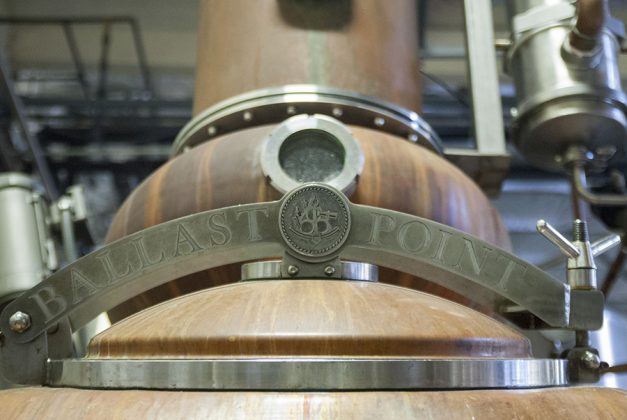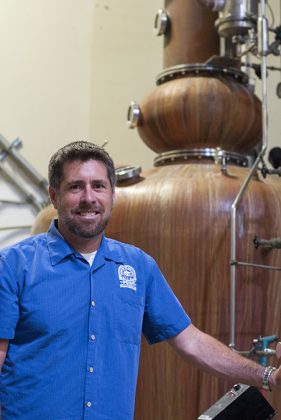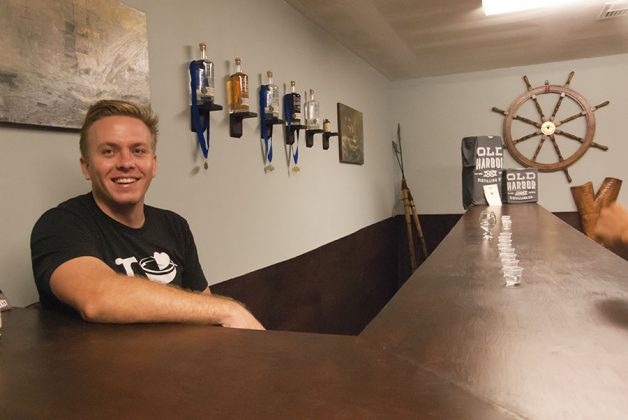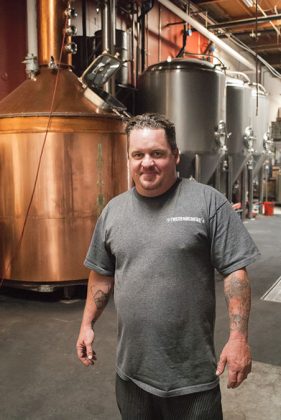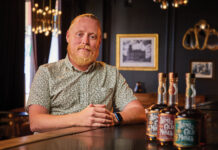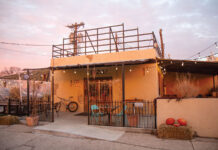In a county that stretches from the outskirts of Tijuana almost to Disneyland in the north, San Diego has more than 70 miles of beaches and 114 breweries to slake prodigious thirsts brought on by incessantly pleasant, spring-like weather. Home brewing is such a popular local pastime that the joke that a person can’t walk 10 feet in San Diego without running into a brewer isn’t really too far off. With so many locals who already know about yeasts, grains and fermentation, and who have a propensity for both experimentation and collaboration, it’s not surprising that more are expanding into distilling.
In a boon to the local distilling scene, California governor Jerry Brown signed AB 1295 in late 2015. Before this new law, California craft distillers were at a disadvantage. Breweries and wineries could have tasting rooms and sell products directly to customers, but distilleries were specifically forbidden from selling directly to consumers. What they could do was offer quarter-ounce pours (up to 1.5 ounces per person, per day) to visitors and tour groups. They could also sell t-shirts, hats and other swag. Before then, even tast ing rooms were forbidden before 2014. But now, some anticipate a gold rush of new distillers—perhaps those who’ve been waiting to see how the new legislation panned out—to finally take the plunge.
When they do, they’ll find an existing corps of distillers who have come onto the scene within the last few years and who consistently help each other. In 2014, the majority of county distillers banded together to form the San Diego Distillers Guild (sandiegodistillersguild.com). Its dual purpose is to promote distilling in San Diego County and raise awareness about San Diego craft spirits more broadly. AB 1295, which takes effect January 1st, 2016, allows, among other things, more robust tasting room options and the ability to sell spirits directly to consumers on site. New distilleries planning to come online will find a welcoming cadre of colleagues willing to advise, support and maybe even lend equipment.
Ray Digilio, for instance, who founded Kill Devil Spirits, says that he wishes he had someone to advise him when he began distilling so that he wouldn’t have had to rely so much on trial and error. Now, he is becoming the man he wishes he had known. Digilio is consulting with about 13 distilleries and has plans to open a distilling school in San Diego where guests can learn about spirits and how to operate a still. “Home distillation is illegal, but we’ve found a few ways that we might be able to circumvent those laws and offer small batches for sale in the tasting room, and maybe run some competitions and get new talent out there.” It’s a notion that harkens to home brew clubs of the last 40 years and that speaks to the collaborative nature of distilling in San Diego. Here, most distillers find it almost a duty to help their peers, to experiment and to collaborate.
Ballast Point Spirits
For almost 20 years, Ballast Point has supplied beer-loving San Diego with award-winning IPAs, lagers, ambers and other suds. What began as a small supply shop catering to local home brewers in the early 1990s has grown into a beer empire, second in size only to Stone Brewing in San Diego County. Ballast Point has leveraged that success in brewing and beer distribution to create a brand of 14 different spirits, ranging from vodka to malt whiskey. Since the company began its distilling program in 2008, it has racked up more than 80 awards for their spirits.
The firm offers samples of its regular, seasonal and limited release beers in all four of its tasting rooms, but until AB 1295 goes into effect allowing direct consumer sales of spirits, those who want to sample its spirits should head to the Scripps Ranch tasting room attached to the distillery. In the production facility, co-founder and head brewer/distiller Yuseff Cherney and his staff use two different stills. One is a 500-gallon hybrid pot/column still made by the venerable American firm Vendome. Another, made of stainless steel, is used to produce two over-proof gins: Ballast Point’s signature Old Grove Gin, with a bit of rose and local coriander as well as a “barrel rested” version aged almost two months in charred oak before bottling.
It’s no surprise that rum is a popular choice for local distillers to make; beach-loving San Diego is home to Tiki Oasis, an annual gathering of Polynesian pop connoisseurs. Cherney’s own affection for Tiki drinks shows in Three Sheets, the company’s rum line. In addition to the basic white expression, there are aged and spiced versions for poolside drinking (though be advised that alcohol is forbidden on local beaches). Ballast Point also bottles non-alcoholic mixers: A Hawaiian-style Mai Tai, as well as spicy and mild versions of Bloody Mary. Just recently, the company created a line of 12-ounce canned cocktails made with spirits distilled at the Scripps Ranch distillery that run about 6 to 10% ABV: Bloody Mary, Rum & Ginger, Rum & Cola and Gin & Tonic.
In addition to gin and rum, Ballast Point makes five vodkas, all named after the deadly puffer fish, Fugu (Ballast Point has a serious fishing and seafood angle to their product names). In addition to the plain Fugu vodka, four flavored versions round out the line: Habanero, Horchata, Piña and hibiscus flowers—called Jamaica in these parts—the last three specifically inspired by the aguas frescas so common in area farmers’ markets taquerias and maricsos shops. Its three whiskeys are Devil’s Share Single Malt Whiskey, aged in new, charred oak barrels; Devil’s Share Bourbon, and Devil’s Share Moonshine, all between 92 and 99 proof. Opah, the firm’s recent liqueur release, will resonate with fans of Italian amari and German Kräuterlikör.
Ballast Point offers tours at its Scripps Ranch location. Expect to see Yuseff Cherney offering special tastings during the ADI conference.
California Spirits Company
Precision Distilling in the North County
In a nondescript industrial Park in San Diego’s North County, Air Force veteran Casey Miles has built an entire distillery around a single recipe; every measure, from the drums of molasses to the polyethylene fermentation tanks, is tuned to that recipe. After leaving the Air Force, the Nebraska native dove into in sales of massive computer systems to governments around the world. The filings, taxes and other Byzantine paperwork that frustrates some distillery owners seem old hat to him. “I used to sell multi-million dollar computers to governments. Compared to those bids that would be hundreds of pages long, where every ‘i’ need to be dotted and every ’t’ needed to be crossed, this is nothing.”
His no-nonsense, streamlined business approach shows in the floor plan of his compact distillery. Every square foot of the space is devoted to producing, bottling and shipping spirits. Although Miles’ brother-in-law lends a hand on occasion, the distillery is designed to be operated by a single person. Surveying the room from the fermentation deck with a satisfied nod, Miles declares, “If it’s not being used, it’s being wasted.”
His main still is a 392-liter model from Müller, a German firm with a growing foothold in the American market, while he deploys a much smaller stainless pilot still in product development and making extracts. Miles says that one area distillers want to use the pilot still for is for making sochu, a low-proof spirit popular as a vodka alternative in San Diego restaurants that lack liquor licenses.
Using his experience in government contracting, Miles built out his distillery, figuring that the safety and production requirements based on what he says is the most common commercial rental footprint in the U.S.: a rectangular 2,000 square foot facility. The company’s main product is Innovo, a maple-filtered silver rum that has garnered several awards (older bottles bear the name Avalon, but a firm with a similar name put the kibosh on that). Starting from the presumption that he could sell a silver rum that complements cocktails rather than making cocktails that highlighted the spirit, Miles reverse-engineered a rum and cola, working through a dozen iterations with different sugars and yeasts, to settle on one rum that shone in the drink.
When he’s not distilling, Miles regularly advises other distillers how to navigate licensing and distribution complexities and set up distilleries. Miles likes to share his experience in building a profitable distillery for $160,000, including the custom-made German still. As of this writing, Miles is compiling a PDF that comprises his experience building, licensing and operating a distillery based on that commonly available rental space. He plans to distribute it, free for the asking, to any distiller who wants to review it and who may want to replicate his model.
Kill Devil Spirit Company
After starting his company with his own cash and even living in a tent in the distillery space, Ray Digilio had invested everything into his venture. Bit by bit, business picked up while he made spirits in a 50-gallon still and sold products door-to-door. Along the way, he helped other distillers with advice and insight. “When people are passionate about this,” he said, “I love lending a helping hand.” It’s a typically San Diego sentiment. When a local casino began placing orders, a large distributor picked up his brand. The business ground to a halt, though, when an electrical blowout in the 700-square-foot distillery stopped production. For Digilio, founder of Kill Devil Spirit Company, that wiring mishap was an opportunity in disguise.
Fortunately, he had been meeting with and consulting an aspiring distiller who had capital but who had not yet gotten his distillery off the ground. What was their solution? Combine forces and shift production to the new 8,000 square foot facility. They are now business partners.
At the new space, Digilio distills Valor, a new American-style gin with mint, grapefruit, and Chinook hops; an unfiltered vodka (“It’s more like what vodka originally was back in Russia,” says the distiller); a cereal moonshine using Vienna malt; and Ugly California Rise & Shine—a coffee-flavored spirit. Digilio asked his friends at Dark Horse Coffee Roasters how hard it would be “to put a gnarly char on some beans,” akin to heavily charred barrels. Not hard at all, they said. The result was Santo Domingo beans roasted so deeply that they’re no good for coffee. “You’d never brew with it,” says Digilio, “but when it sits in the barrel with moonshine, you get a roasty infusion with chocolate and caramel flavors.” Digilio has been using a 300-liter stainless steel and copper Chinese still, but the firm is already outgrowing it. Plans are afoot to design a new vodka still.
By the spring, the new facility will be built out with a tasting room. Digilio says they’d love to have guests come by. Also in the works: A school where aspiring distillers can learn fermentation and distilling and get hands-on practice operating a still as well as a satellite tasting room in San Diego’s North Park, home to bars such as Seven Grand, Coin-Op, Hamilton’s and Toronado.
Liberty Call Distilling
Dunder and Lightning in Spring Valley
Not every San Diego distiller’s career began with home brewing, but homemade beer certainly is a gateway beverage for many. At some point, a whole lot of area brewers have had the epiphany that distilling alcohol is just a few steps away from brewing it. Bill Rogers, co-founder of Liberty Call Distilling, was such a home brewer. Navy vet Steve Grella, who would become Rogers’s partner, hails from Tennessee, has family connections to what we’ll call “American folk distilling,” and procured a spot of moonshine. Rogers sampled, liked it and reasoned, “You know, we could probably make that.”
After running the numbers, Rogers started the permitting process on a new distillery where he, Grella, and a third partner, Addison Poth, now make gin, rum, and whiskey. Our local taste for slightly over-proof spirits shows in their selection: all Liberty Call spirits are bottled at 45% ABV. Rogers calls his still, cobbled together from pieces made by three separate manufacturers, “a complete Frankenstein job.” His colleague, Casey Miles, at California Spirits Company even pitched in a condenser. Liberty Call contracts with a local brewery to brew a custom mash with equal measures of corn, wheat, rye and barley. It is fermented with the brewery’s beer yeast, distilled, then aged in a solera system of multiple barrels that include cherry wood and white ash. He feels that in-barrel agitators, developed in conjunction with a local firm, help accelerate maturation. They call the result 4 Grain Whiskey.
Adapting the Caribbean dunder-pit process to his San Diego distillery (“but without any nasty meat,” he clarifies), Rogers created a dunder barrel from washes of previous rums, all of which are made with evaporated cane juice. A part of that dunder is fed into new washes and allowed to ferment with wild yeast. Liberty Call’s resulting 90-proof white rum carries fruit esters and a restrained but noticeable funk. Some of that white rum is flavored with peppercorns, cinnamon, nutmeg and other spices, aged in charred oak, and rounded out with house-made caramel. Other rum goes into making 90-proof San Diego County Gin with lavender, chamomile, several types of citrus, coriander and three other flowers.
Malahat Spirits
Like several San Diego area distilleries, Malahat Spirits is tucked away in an industrial park on a tree-lined street laid out from end to end with identical-looking buildings. With an entrance more befitting a maritime museum than a distillery though, Malahat loses the industrial vibe as soon as visitors open the door. After visitors wend their way through a short labyrinth inspired by the West Coast Prohibition-era rum-running ship after which the distillery is named, the guests emerge into the distillery proper.
Inside, two beautiful copper rigs dominate the room. The larger of the two is the workhorse of the distillery: A 1000-liter Kothe Destillationstechnik still on which owners Tom Bleakely, Tony Grillo and Ken Lee make whiskey and rum. A smaller 150-liter experimental still sits off to the side. Robert Birnecker from Koval distillery in Chicago salvaged that 35-year-old still from a German farmhouse and brought it to America for Malahat. The size, the trio agree, is the smallest they can use to develop recipes that are replicable on the larger still. With wait lists getting longer and longer for custom-made stills, importing used and refurbished stills from Europe can be a smart move for new distillers eager to get started on production.
Although Grillo mixed rum and colas as a child for his Puerto Rican grandfather, and Lee has been a whiskey aficionado for more than 20 years, the trio had no hands-on distilling experience when they decided to open a distillery. They attended seminars and workshops and read widely, but the true litmus test for their spirits was their own tastes. So they drank a lot of liquor, focusing on qualities they liked as they forged what would become their own spirits. “We don’t buy a single drop made by someone else,” Lee says, “There are no lugs of GNS or Midwestern whiskey here.” Bleakely was quick to jump in: “You won’t find any spirits in here older than the distillery itself.”
They also paid special attention to the yeast strains, a factor that every brewer in San Diego understands can affect a beverage’s flavor. “We didn’t care so much about the yield,” explained Grillo. “We wanted the yeast strain with the best flavor.” The resulting silver rum, made with a blend of two different kinds of molasses, is the base of all their aged and flavored varieties. Black tea plays well in an Arnold Palmer as well as more elegant punches, ginger boosts tropical drinks and toddies, an aged expression that gets additional complexity from resting in used cabernet barrels (this is, after all, California, where the tendrils of grapevines have a far reach), and a spiced rum. The last, rather than being a typical Caribbean spiced rum, is redolent with northern European spices. It suggests the Nürnberg gingerbread—called lebkuchen—complete with a Madagascar vanilla icing.
Malahat also makes straight bourbon and 100% rye whiskey. Neither is quite ready for market, but each is bound to make a splash when they’re released. The tasting room (tasting area, really) is a bar in full view of the stills and racks of aging spirits. Savvy visitors, if they ask nicely, may be able to sample some of those whiskeys before they’re released to the public.
Old Harbor Distilling Co.
During the summer, when the Pacific waters off San Diego Bay can climb into the mid 70s, hammerhead sharks come out to hunt. Though the fearsome looking sharks aren’t particularly dangerous to tourists (their tiny mouths are better suited to smaller prey), cautious visitors may want to track down a safer shark encounter—the enormous blue and black hammerhead mural gracing Old Harbor Distilling Co.
Housed in an otherwise nondescript grey ClearSpan warehouse in the East Village neighborhood near the water, Old Harbor is one of the city’s newer distilleries. As one of the founders of Mike Hess Brewing, founder and head distiller Michael Skubic has earned a wealth of good will from area bartenders. Skubic’s background as a brewer gave him a head start on much of the technical details of distilling such as grains, fermentation controls and yeast strains. In fact, his ongoing and casual collaboration with Hess—which provides yeast for Old Harbor—is yet another example of the collaborative nature of San Diego distilling.
On his 1,000-liter Kothe hybrid pot/column still, Skubic makes rum and gin. He also produces Ampersand, a lightly sweetened coffee cordial made in conjunction with Coffee & Tea Collective, and a line of cocktail bitters developed by San Diego bartenders Ryan Andrews, Eric Lockridge and Brett Winfield. While whiskeys (two single malts, rye and bourbon) are still in development, Skubic’s gin and rums are fast becoming local favorites.
Barrelflag, Skubic’s Navy strength rum, is another example of San Diegans’ affinity for stiff spirits that stand up in mixed drinks. The 144-proof rum is made with molasses, evaporated cane juice, rich demerara sugar and brewer’s yeast.
The distillery’s flagship spirit, San Miguel Southwestern Gin, blends cucumber, coriander, cilantro, and sage with lime and the juniper in a nod to the area’s native plants, as well as its Hispanic heritage and food ways. San Miguel, after all, was the name bestowed on the landing where navigator Juan Rodriguez Cabrillo came ashore here in 1542. Expect another gin, 1542, in the near future that will be based on native Southern California botanicals. Visitors may take tours and sample the spirits in the distillery’s tasting room.
At Ironside Fish & Oyster, bartenders mix the San Diego distiller’s 94-proof San Miguel Gin with lime juice, Basil Eau de Vie from St. George Spirits, muddled cucumber, celery bitters, and a bit of sea salt. What do locals think? The bracing antifogmatic, dubbed The Skubic Diver, won San Diego Magazine’s best cocktail
of 2015.
San Diego Distillery
Trent Tilton planned to distill a few one-off batches of brandy at San Diego Distillery. When he realized that regional wineries—which did not have distilling permits—had an ongoing need for grape spirits that they could use to fortify their port wines, he began to develop contract brandy distilling as an integral part of his business. Tilton converts wines such as cabernet sauvignon, chardonnay and sauvignon blanc that are slightly off spec or not quite what vintners want in spirits. Most of them go back to the wineries, but a few spirits end up in secondhand barrels in his Spring Valley distillery. With the recent change in California’s craft distilling laws, he plans to offer small releases of single barrel brandies in the future.
There are no plans for broad-spectrum distilling, though. “San Diego already has clear spirits. We have plenty of rums and I don’t want to make gin or vodka,” Tilton says. Grape brandies aside, his clear love is for grains. A home brewer since the turn of the millennium, Tilton once took on a position at a local commercial brewery to get hands-on experience in large-scale production. He’s used that experience in his distillery to develop whiskeys on a 380-liter still, including bourbon with just a hair over the legal minimum of corn: 51.5%. The rest? Tilton is mum on the mash bill, but promises extraordinary whiskey when it matures. His rye whiskey is 75% rye with the remainder a rotating slate of grains. He plans to offer them as limited releases at the distillery.
Tilton and his wife are both fans of both single malt and peated whiskeys. It’s no surprise that 16-year-old Lagavulin ranks among his favorite drams, or that he often uses heavily peated grains in his mashes. A longtime member of an informal group of area whiskey aficionados called San Diego Whisk(e)y Enthusiasts*, the distiller occasionally breaks out a bottle of his clear peated whiskey when the group meets. “They love it,” he says. “Almost nobody has ever tried clear peated whiskey, so it’s always a big hit.” For now, everything Tilton distills goes either to winemakers or into barrels. Visitors to the small distillery, though, will one day have the chance to buy his unusual spirits on site.
*For visiting distillers who want to tap the local whiskey scene before coming for the 2016 ADI conference, check out the San Diego Whisk(e)y Enthusiasts’ Facebook group: www.facebook.com/groups/SanDiegoWhiskeyEnthusiasts
Twisted Manzanita
Philadelphia’s loss is San Diego’s gain. Young Jake Pittman didn’t know enough back in the City of Brotherly Love not to tell the Philly mob that he simply would not pay protection money for his fledgling spirits business. When one of their representatives told Pittman that he would have to leave town and never come back, the California native sold his car (to that same mafioso who gave him walking directions), counted his lucky stars and headed back west. In time, Pittman became the cofounder and head distiller of Twisted Manzanita Spirits.
Time and again in San Diego, we see brewers use their knowledge of grains, yeast and fermentation as a gateway to stiffer stuff. About 20 minutes east of downtown San Diego, past the hiking trails of Cowles Mountain, Twisted Manzanita’s distillery is an offshoot of a successful brewery of the same name, just a door or two down. In fact, the distillery is so close to the brewpub that employees shuttle between the two properties on little scooters while worts brewed to Pittman’s specifications are pumped directly from the brewery through pipes to enormous stainless steel fermentation tanks in the distillery. In the front of the distillery, a little tasting room awaits bigger things once California allows distillers more latitude offering cocktails and direct customer sales.
Pittman has a 5-gallon pilot still from Mile Hi Distilling in Colorado, but the real beauty in his distillery is a 1,400-gallon copper still graced with an elegant, scrolling, multicolored filigree pinstripe. The handmade still is one of San Diego’s largest. Pittman uses it to make various rums, “moonshines,” fruit-flavored spirits and brandies; but his 95-proof Rebellious Rye—a 70/30 mix of rye and two-row malted barley—is something special. The Champagne yeast he uses may have something to do with that. A barrel-aged gin, distilled from Coronado Brewing’s Frog’s Breath citrus-forward IPA, is redolent with citrus and coriander and may be ready for the 2016 ADI conference. Look for a new satellite tasting room in the city’s North Park neighborhood, about a five-minute drive from the San Diego Zoo.
Twisted Manzanita also does contract distilling for California wineries that lack distilling permits. When a batch of wine isn’t just exactly what the vintners want—or they’ve simply made too much, Jake runs it through the still to make brandy. Some may be sold as brandy, and some used to fortify California port wines. A brandy made from Julian apples—a mountain town about 45 minutes east of San Diego—is in the works, but not quite ready for release.
Kalifornia Distilleries
“Scratch a San Diego distiller,” goes one bit of local lore, “and you’ll find a brewer.” There’s a grain of truth in that. More than a few area distillers have backgrounds in home or commercial brewing, but that little bon mot is far from a universal truth. Like distillers across U.S., those in and around America’s finest city have backgrounds ranging from computer tech to engineering. One family’s distilling lineage, though, goes back to 1731.
Bill Tiller began bottling his own corn whiskey in January 2015. “Our first legal bottles, anyway,” he clarifies. Tiller traces his family to 18th century Cork, Ireland, and maintains that distilling spirits is a craft that has been taught from father to son in his family since then. “It probably goes back farther, but you can never quite be sure with the Irish.” This much is certain: Without prodding from his son (also named Bill), the North County distiller probably never would have begun a commercial facility. After suggesting that they open a distillery together, Bill Jr. spent a year researching options and regulations, then submitted a business plan to his father.
The family pulled together and launched Kalifornia Distilleries in the Temecula Valley, an area about 70 miles north of downtown San Diego, known more for its wineries than distilleries. The Tillers are working to change that. Using a 350-gallon still for stripping runs and a smaller spirit still, they make vodka, bourbon, unaged corn whiskey and flavored “moonshines.” Bill Sr. is quick to explain that those last few aren’t really moonshine. “We never called it that growing up; it was just liquor, but moonshine is a word people recognize.” The apple pie- and peach pie-flavored cordials are made with spices, local organic fruits, and Tiller’s own corn whiskey. While label approval took several rounds of submissions for those bottles, local demand for vodka and corn whiskey took off so much that keeping up with demand has been a challenge. “They blew up faster than we could ever imagine.” Bloody Marys and a Temecula Margarita, both made with their corn whiskey, are popular around town and help drive sales.
“I’m blessed,” Tiller explains. “I get to make liquor with my family. That’s what we do.” Visitors can sample the Tillers’ spirits and tour the distillery, but the man with 300 years of whiskey in his veins suggests that visitors call ahead. “Otherwise, they might show up and we’ll be elbow-deep in corn!”

